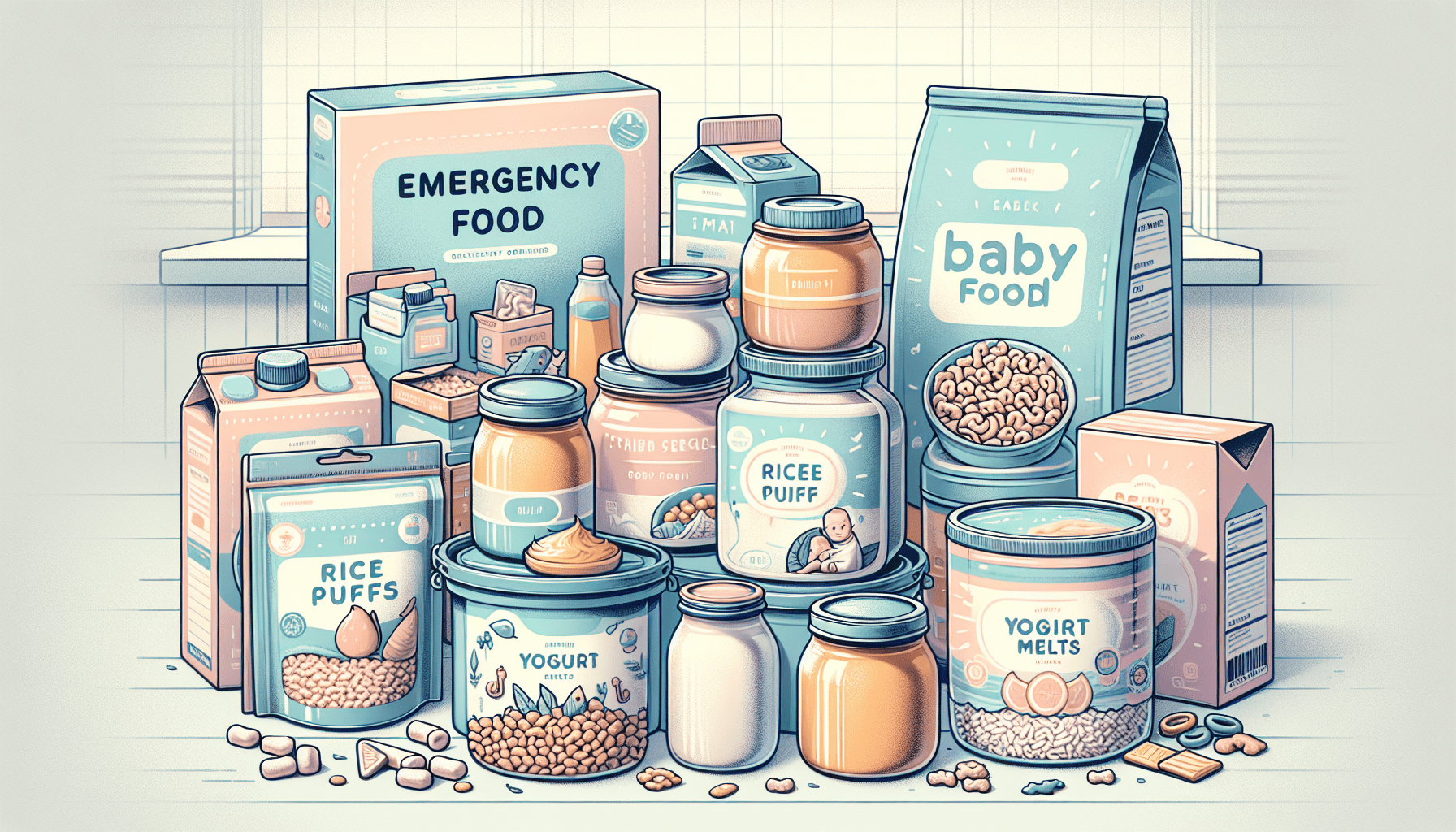Have you ever found yourself worrying about ensuring that your infant or young child has enough to eat during an unexpected emergency situation? It’s a common concern for parents and caregivers. Emergencies can strike without warning, whether it’s a natural disaster, power outage, or any other situation that disrupts daily life. In these times, having a plan for feeding your little ones becomes crucial, ensuring they get the nutrition they need even when circumstances are less than ideal. Let’s explore some emergency food options tailored for infants and young children, so you can feel prepared and confident in providing for their needs no matter what.

Understanding Infant and Young Children’s Nutritional Needs
Before delving into emergency food options, it is essential to understand the nutritional requirements for infants and young children. Infants primarily rely on breast milk or infant formula for their nutritional needs. As they grow and begin to transition to solids, there’s a need for more variety to ensure they receive a balanced diet.
Nutritional Needs of Infants
Infants under six months generally thrive on breast milk or formula alone. These provide all the essential nutrients, including liquids necessary for hydration. As infants reach six months, they typically begin to explore solid foods. However, breast milk or formula remains their main nutrition source throughout the first year.
Nutritional Needs of Young Children
Once children become toddlers, their nutritional needs diversify further. Balance is crucial—offering protein, carbohydrates, healthy fats, vitamins, and minerals. During emergencies, keeping this balance becomes tricky but not impossible.
Emergency Preparedness for Feeding Infants and Young Children
Preparing for emergencies involves planning ahead and stocking your pantry with essential items. It’s important to consider the perishability, nutritional content, and ease of preparation of selected food options.
Stocking Up on Essentials
When stocking up for emergencies, aim to have a mix of the following:
-
Breast Milk (if applicable): Nursing mothers might consider having a supply of expressed milk in case urgent situations make direct breastfeeding difficult.
-
Infant Formula: If your baby relies on formula, keep an adequate supply of powdered formula, which has a longer shelf life than its liquid counterparts.
-
Canned and Jarred Baby Foods: These are convenient for emergencies due to their long shelf life and convenience.
-
Dry Cereals and Purées: These can serve as nutritious options for young children, easy to store and prepare.
Knowing What to Avoid
While it may be tempting to rely on all shelf-stable foods, some are unsuitable for infants and young children. Avoid items with:
- High sugar and salt content.
- Artificial additives or preservatives.
- Potential allergens without prior introduction to your child.
Emergency Food Options for Infants
Depending on the age and dietary needs, options vary. Let’s break down what’s suitable for different stages.
Breast Milk
For breastfeeding moms, manual or electric breast pumps can make a world of difference. Expressing milk before the emergency ensures a backup supply, which can be stored safely:
-
Storage: Use breast milk storage bags and label them with the date. Freeze for long-term use (up to six months).
-
Thawing: Thaw in the fridge when required. For emergencies, if refrigeration isn’t available, placing the milk in a cool, safe corner of your home might extend its freshness temporarily.
Infant Formula
Having an ample supply of infant formula is crucial. Consider the following points:
-
Powdered Formula: Most versatile, with a longest shelf life. Make sure your water supply is safe for mixing.
-
Concentrated Liquid: Easier to prepare but occupies more space.
-
Ready-to-feed Formula: Convenient but heavier and takes up more storage room.
Canned and Jarred Baby Foods
When selecting canned or jarred foods, prioritize organic options low in added sugars and salts. Fruits (like applesauce) and vegetables provide essential vitamins.
Dry Cereal
Suitable options include:
- Oatmeal: Quick to prepare and easy to store, providing fiber and essential nutrients.
- Rice Cereal: Often fortified with iron, making it a good emergency staple.
Emergency Food Options for Young Children
Older infants and toddlers require diverse food options to meet varied nutritional needs.
Shelf-Stable Milk
Shelf-stable milk, including plant-based options like almond or soy milk, can offer versatility and necessary calcium and vitamins if fresh milk is unobtainable.
Nutrient-Dense Snacks
Snacks that pack a nutritional punch include:
-
Dried Fruits: Portable and packed with vitamins. Opt for varieties without added sugars.
-
Whole-Grain Crackers: Pair well with nut butters or cheese spreads, offering a balanced snacking option.
Nut Butters and Spreads
Perfect for energy and protein, ensure you introduce these gradually due to allergy potential. Always have nut-free alternatives like sunflower seed butter if peanuts or tree nuts pose a concern.
Ready-to-Eat Meals
Brands like Happy Family and Gerber offer toddler-specific meals, often containing a mix of grains, lean proteins, and vegetables, designed to be consumed without extra preparation.

Methods of Storing Emergency Foods Safely
Storage plays a critical role in maintaining your emergency food supply’s quality and safety.
Proper Location
- Cool, Dry Areas: Prolongs shelf life.
- Low Humidity Levels: Mold thrives in moisture-rich environments.
Use Airtight Containers
For opened packages, having airtight containers ensures food remains fresh longer and avoids pest issues.
Regular Check-Ups
Rotate your supply regularly, using a “first in, first out” method to ensure nothing expires.
Preparing for Emergency Nutrition
Having the right supplies alone isn’t sufficient. Preparation knowledge is equally important.
Food Preparation Without Electricity
If power is out, you might need to get creative:
- Alternative Cooking Gear: Consider a portable camping stove or solar cookers for food preparation.
- Boiling Water: Use sterno cans or portable burners to heat water or cook simple meals.
Hygiene Essentials
Cleanliness remains non-negotiable, even during emergencies:
- Baby Wipes: Useful for cleaning both hands and keeping feeding areas hygienic.
- Bottled Water: Essential for drinking, food preparation and even cleaning when tap water lacks safety.

Managing Food Allergies During Emergencies
Being prepared for food allergies can prevent adverse reactions when choices are limited.
Allergy Safe Foods
- Stock up on known-safe items your child enjoys.
- Keep a list of common allergens to avoid in case someone else plans meals.
Emergency Medications
Maintain a supply of necessary medications, including epinephrine auto-injectors, and know their expiration dates.
Adapting to Emergency Food Challenges
Emergencies increase the need to adapt quickly. Here’s how to handle some potential challenges:
Feeding In Picky Eaters
Maintain familiarity with comfort foods, potentially softening the impact of dietary changes due to emergency constraints.
Maintaining Calm in Young Children
Develop a strategy for comforting your child, establishing a sense of normalcy amidst chaos with routine feeding times and familiar foods.

Conclusion
Having an emergency food plan for infants and young children can ease worries during unforeseen situations. By understanding your child’s nutritional needs and exploring a broad spectrum of reliable food options, you ensure a steadied approach, no matter what surprises might come your way. Preparedness empowers you to protect your child’s wellbeing, making life’s unpredictable moments a little more manageable.

